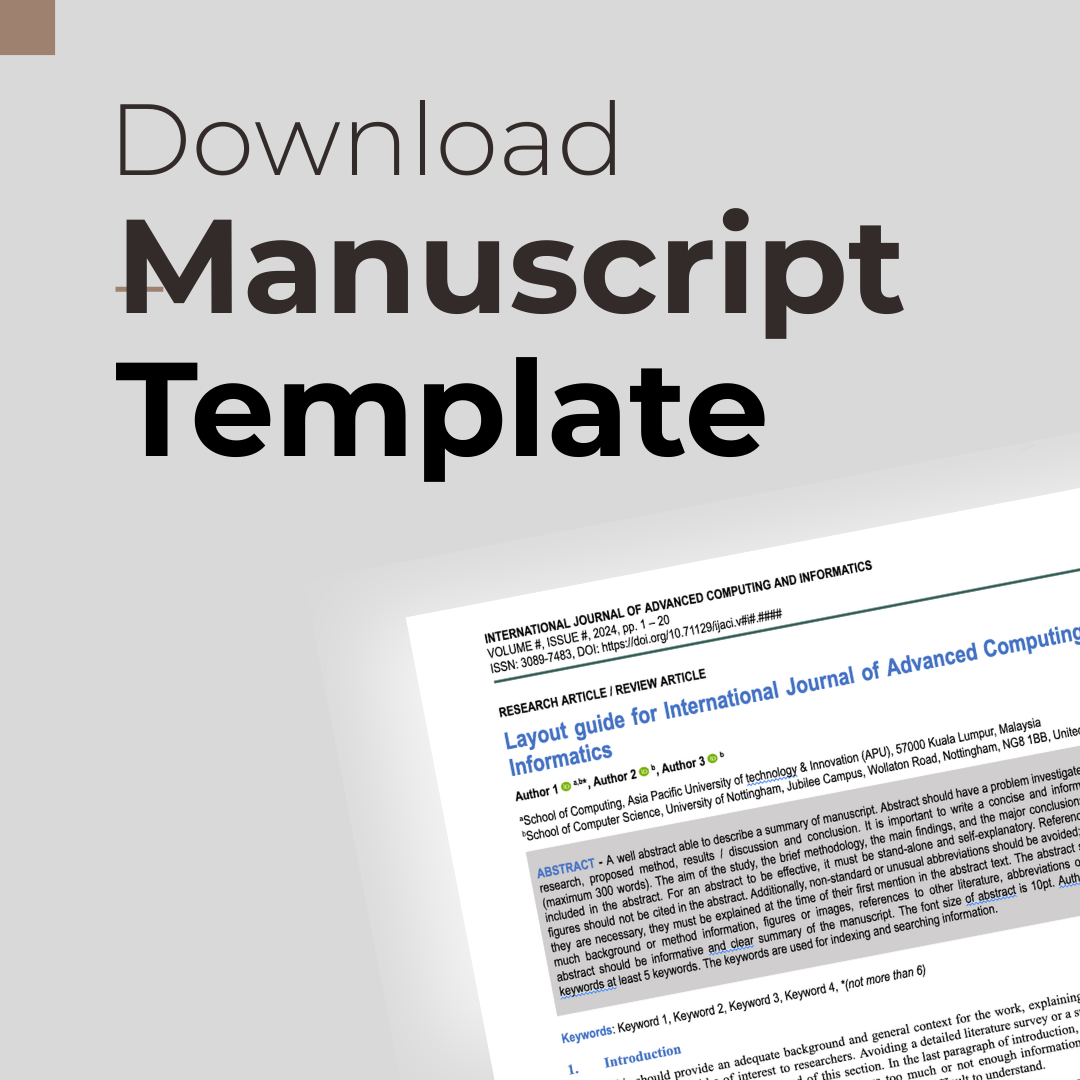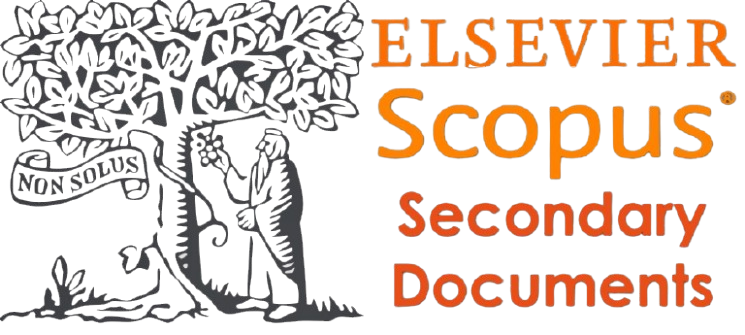
Author Guidelines
- 1.1 Article Structure
- 1.2 What should you submit?
- 1.3 Procedures
- 1.4 Peer Review
- 1.5 Disclaimer
- 1.6 Copyright Notice
1.1 Article Structure
The manuscript should be compiled in the following order:
- Title page
- Abstract, Keywords
- Introduction
- Related Works
- Methods
- Results
- Discussion
- Conclusion
- Acknowledgment(s)
- Conflicts of Interest
- References
Title Page
Please make sure your title page contains the following information. The title should be concise and informative. The title should be brief, concise, and descriptive. It should not contain any literature references or compound numbers or non-standardized abbreviations.
Author information
- The name(s) of the author(s)
- The affiliation(s) of the author(s), i.e. institution, (department), city, (state), country
- A clear indication and an active e-mail address of the corresponding author
If address information is provided with the affiliation(s) it will also be published.
For authors that are (temporarily) unaffiliated we will only capture their city and country of residence, not their e-mail address unless specifically requested.
Abstract
Please provide an abstract of 150 to 300 words. The abstract should not contain any undefined abbreviations or unspecified references. The abstract should be self-contained, citation-free, and should not exceed 300 words. The abstract should briefly describe the purpose of the study, how the investigation was performed, the most important results, and the principal conclusions that were drawn from the results, respectively. Nonstandard or uncommon abbreviations should be defined at first mention within the abstract.
Keywords
Please provide 4 to 6 keywords which can be used for indexing purposes.
Introduction
This section should be succinct, with no subheadings. The author(s) should strive to define the significance of the work and the justification for its publication. Any background discussion should be brief and restricted to pertinent material.
Related Works
This part should contain sufficient detail of the current existing work and solution. Previously published methods should be indicated by a reference and only relevant modifications should be described.
Method
This part should contain sufficient detail that would enable all procedures to be repeated. It can be divided into subsections if several methods are described. Authors should be as concise as possible in experimental descriptions. The experimental section must contain all of the information necessary to guarantee reproducibility.
Results and Discussion
The study results should be clear and concise. Restrict the use of tables and figures to depict data that is essential to the message and interpretation of the study. The results should be presented in a logical sequence in the text, tables and illustrations. The discussion should explore the significance of the results of the work, not repeat them.
Conclusion
The main conclusion(s) of the study should be presented in a short conclusion statement highlighting the goals of the study and its importance.
Funding (information that explains whether and by whom the research was supported)
Conflicts of interest/Competing interests (include appropriate disclosures)
Authors' contributions (optional: please review the submission guidelines from the journal whether statements are mandatory)
Text Formatting
Manuscripts should be submitted in Word.
- Use a normal, plain font (e.g., 10-point Times Roman) for text.
- Use the automatic page numbering function to number the pages.
- Do not use field functions.
- Use tab stops or other commands for indents, not the space bar.
- Use the table function, not spreadsheets, to make tables.
- Use the equation editor or MathType for equations.
- Save your file in docx format (Word 2007 or higher) or doc format (older Word versions).
Headings
Please use no more than three levels of displayed headings.
Abbreviations
Abbreviations should be defined at first mention and used consistently thereafter.
Acknowledgments
Acknowledgments of people, grants, funds, etc. should be placed in a separate section on the title page. The names of funding organizations should be written in full.
References
Citation
Cite references in the number. For example:
The concept of opposition-based learning (OBL) can be used to improve the performance of population-based optimization algorithms [1].
Reference list
The list of references should only include works that are cited in the text and that have been published or accepted for publication. Do not use footnotes or endnotes as a substitute for a reference list.
Text: Indicate references by Arabic numerals in brackets, which run in order of appearance throughout the text (Vancouver style). For instance [4] or [7-10, 13,15]. The actual authors can be referred to, but the reference number(s) must always be given.
Example:
[1] K. R. Chetan and S. Nirmala, “An efficient and secure robust watermarking scheme for document images using Integer wavelets and block coding of binary watermarks,” Journal of Information Security and Applications, vol. 24–25, pp. 13–24, Oct. 2015, doi: 10.1016/j.jisa.2015.07.002.
[2] Y. Luo et al., “A multi-scale image watermarking based on integer wavelet transform and singular value decomposition,” Expert Syst Appl, vol. 168, p. 114272, Apr. 2021, doi: 10.1016/j.eswa.2020.114272.
[3] F. Ernawan and D. Ariatmanto, “Image watermarking based on integer wavelet transform-singular value decomposition with variance pixels,” International Journal of Electrical and Computer Engineering (IJECE), vol. 9, no. 3, p. 2185, Jun. 2019, doi: 10.11591/ijece.v9i3.pp2185-2195.
[4]L. De Lathauwer, B. De Moor, and J. Vandewalle, “A Multilinear Singular Value Decomposition,” SIAM Journal on Matrix Analysis and Applications, vol. 21, no. 4, pp. 1253–1278, Jan. 2000, doi: 10.1137/S0895479896305696
Tables
- All tables are to be numbered using Arabic numerals.
- Tables should always be cited in the text in consecutive numerical order.
- For each table, please supply a table caption (title) explaining the components of the table.
- Identify any previously published material by giving the original source in the form of a reference at the end of the table caption.
Electronic Figure Submission
- Supply all figures electronically.
- Indicate what graphics program was used to create the artwork.
- For vector graphics, the preferred format is TIFF format. MSOffice files are also acceptable.
- Vector graphics containing fonts must have the fonts embedded in the files.
- Name your figure files with "Fig. 1" and the figure number, e.g., Fig.1.tiff.
- Combination artwork should have a minimum resolution of 600 dpi.
Figure Numbering
- All figures are to be numbered using Arabic numerals.
- Figures should always be cited in text in consecutive numerical order.
- Figure parts should be denoted by lowercase letters (a, b, c, etc.).
Figure Captions
- Figure captions begin with the term Figure in bold type, followed by the figure number, also in bold type.
- No punctuation is to be included after the number, nor is any punctuation to be placed at the end of the caption.
Permissions
If you include figures that have already been published elsewhere, you must obtain permission from the copyright owner(s) for both the print and online format. Please be aware that some publishers do not grant electronic rights for free and that Springer will not be able to refund any costs that may have occurred to receive these permissions. In such cases, material from other sources should be used.
English Language Editing
For editors and reviewers to accurately assess the work presented in your manuscript you need to ensure the English language is of sufficient quality to be understood. If your manuscript is accepted, it will be checked by our copyeditors for spelling and formal style before publication.
1.2 What should you submit?
Submitted contributions undergo a single-blind peer-review process. In order to make this possible, please:
- Submit a PDF file with the authors' names and affiliations. The submission has not been previously published, nor is it before another journal for consideration.
- Once your paper is accepted, please upload a final DOC, DOCX or RTF version with the authors' names in it.
1.3 Procedures
- Article submission
- Decision about acceptance for review
- Peer Review (around 6 weeks)
- If accepted, the author will receive notification of acceptance, and upload of the final version in DOC, DOCX or RTF version will be required.
- When the final version have been received, the paper will be scheduled – provisionally – for an issue
- Later: the page proof is announced
- The page proof will be sent (make sure you reply)
- Your paper will be published
1.4 Peer Review
The work undergoes an initial review process conducted by an editor. The document will undergo evaluation within the office to determine its suitability in relation to our emphasis and scope, as well as to identify any significant methodological flaws. The paper will undergo a single-blind peer-review process, where it will be given to a minimum of two anonymous reviewers. The comments from reviewers are thereafter forwarded to the associated author for appropriate actions and answers. The proposed choice will undergo evaluation during an editorial board meeting. Subsequently, the editor will provide the ultimate determination to the author who is responsible for the associated submission.
The Research Integrity team periodically seeks external counsel outside the scope of conventional peer review, particularly for proposals that involve significant ethical, security, biosecurity, or societal considerations. Prior to making any decisions, such as the recruitment of reviewers with specialized knowledge, the evaluation by additional editors, or the rejection of a submission, it is advisable to seek guidance from specialists and the academic editor.
Revised manuscripts
When you revise your manuscript, upload your revised submissions including the following files:
Clarifying the changes you have made since the original submission by using the "Track Changes" option in Microsoft Word. Upload this as a "Revised Article with Changes Highlighted" file.
Response to reviewers:
Type the specific points made by each reviewer. Include your responses to all the reviewers' and editors' comments and list the changes you have made to the manuscript. Upload this document as a "Response to reviewers" file.
After Acceptance
Upon acceptance, your article will be exported to production to undergo typesetting. once the typesetting is complete, you will receive the proofs.
1.5 Disclaimer
Responsibility for the contents rests solely upon the authors and not upon the journal, the publisher, its committees/boards or its members.
1.6 Copyright Notice
Open Access: This is an Open Access journal. All articles are available in PDF format immediately upon publication, free of charge and without any subscription. Any user may download, print, or copy the articles or use them for any other lawful purpose, as long as the licensing terms are respected.
Copyright: Authors retain the copyright and the publishing rights for their article without any restrictions.
The submitting author warrants that the submission is original and that they are the author of the submission together with the named co-authors; to the extent the submission incorporates text passages, figures, data or other material from the work of others, the submitting author has obtained any necessary permission.
Licensing: Articles in this journal are published under the Creative Commons Attribution Licence (CC-BY 4.0). This means that users may share and adapt the articles published on this website in a reasonable manner, but they must give appropriate credit of the creator and indicate the changes they have made. Furthermore, users must not apply additional restrictions, but must publish the work under the same license (CC-BY 4.0).




